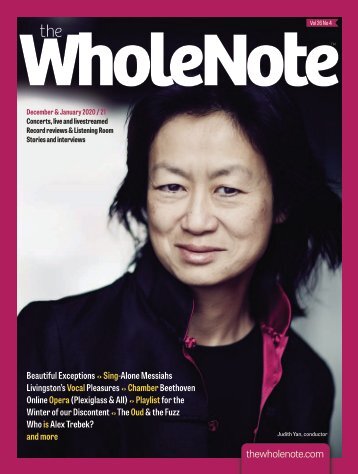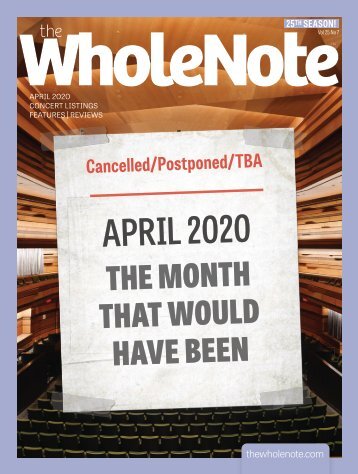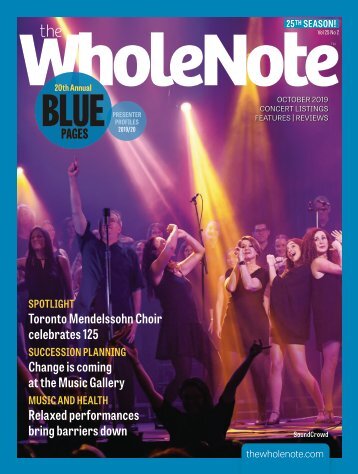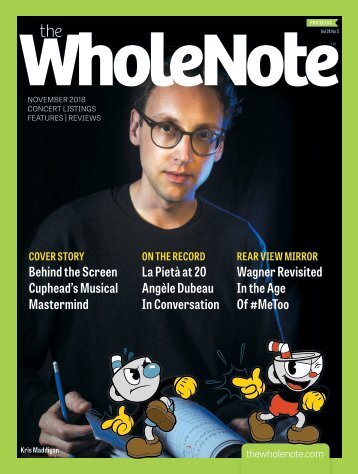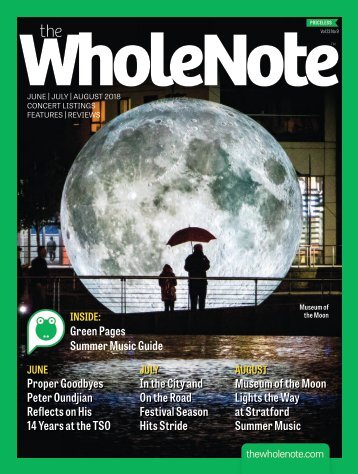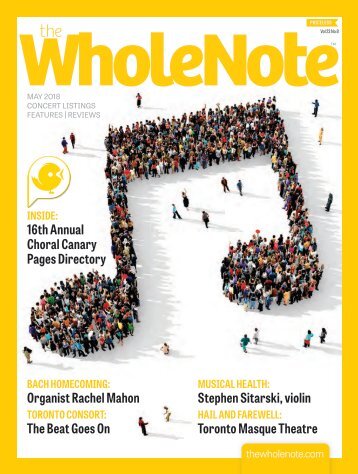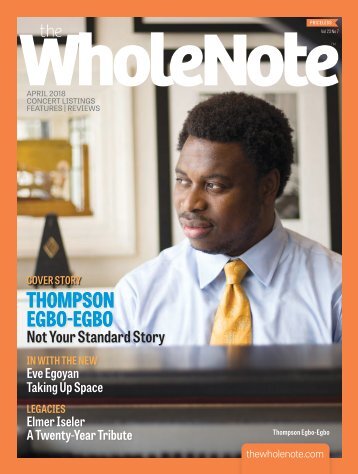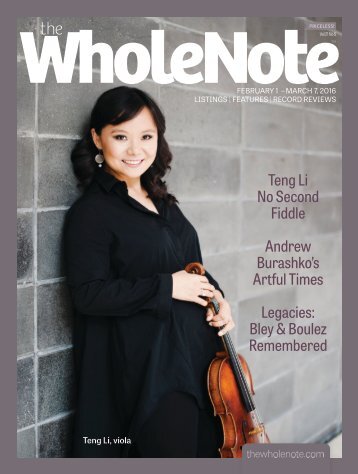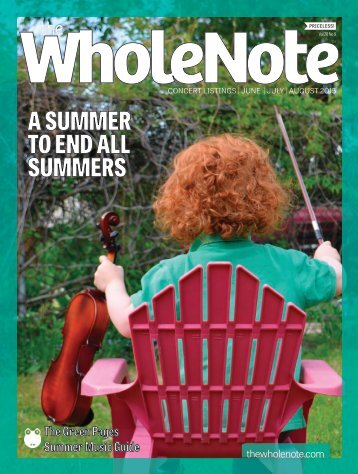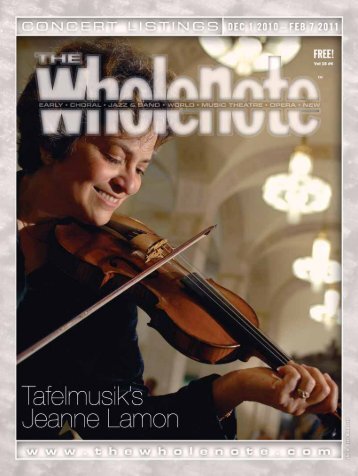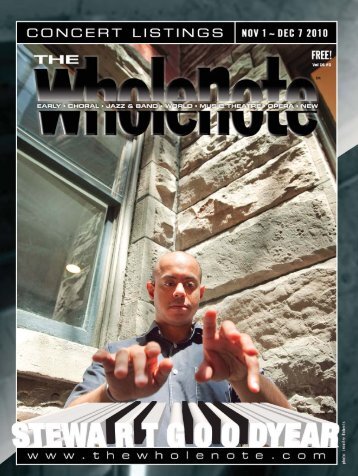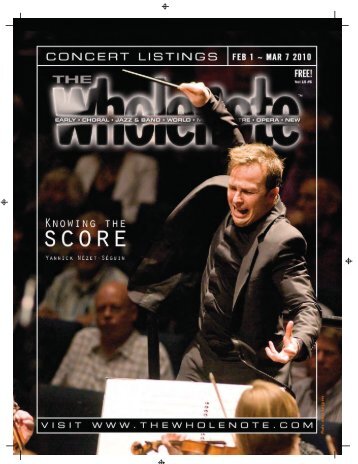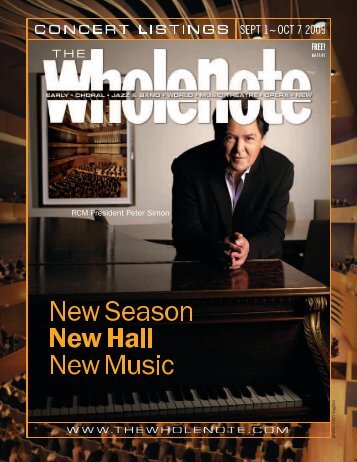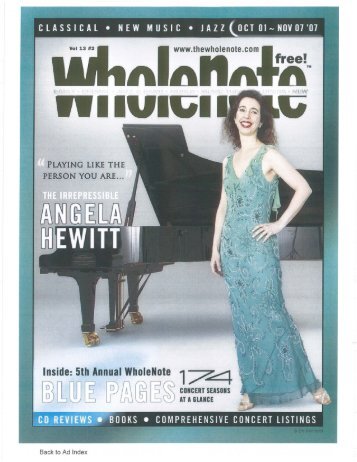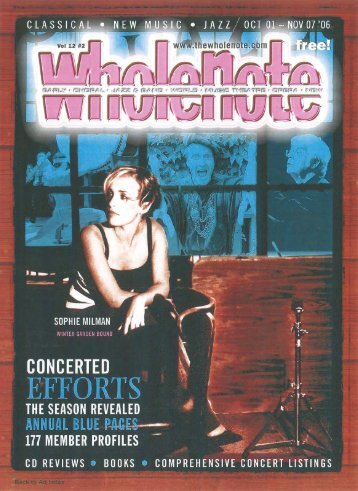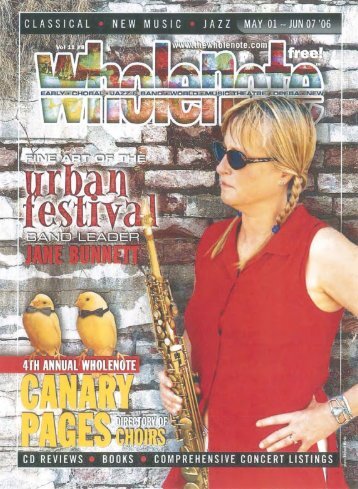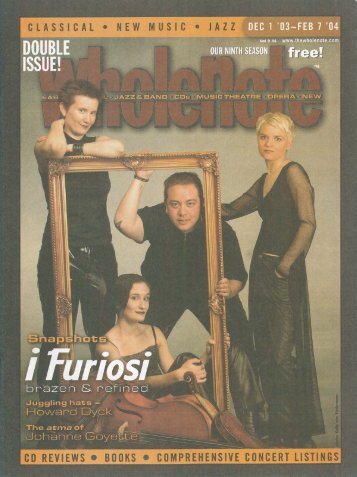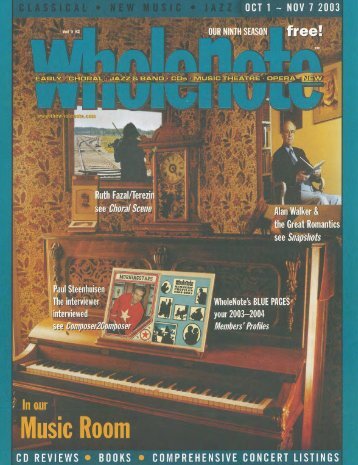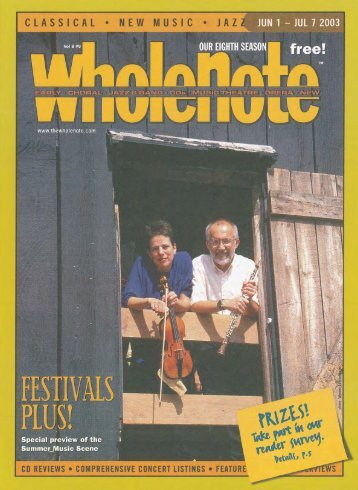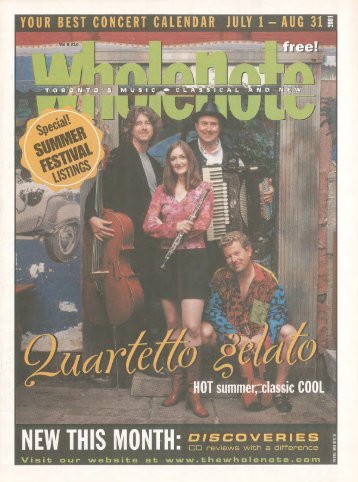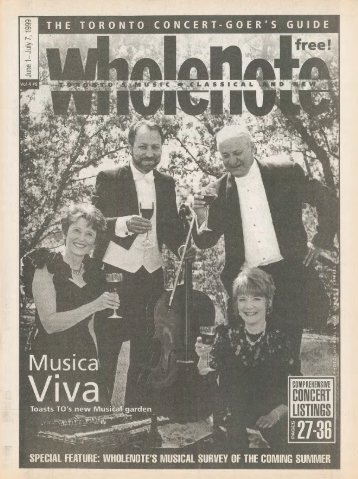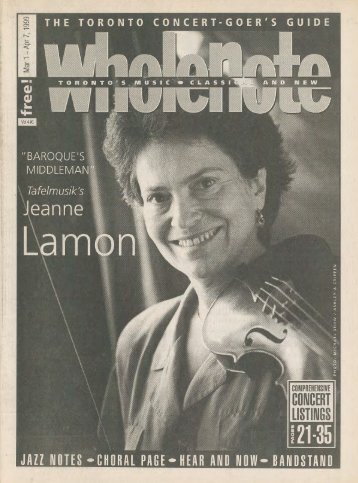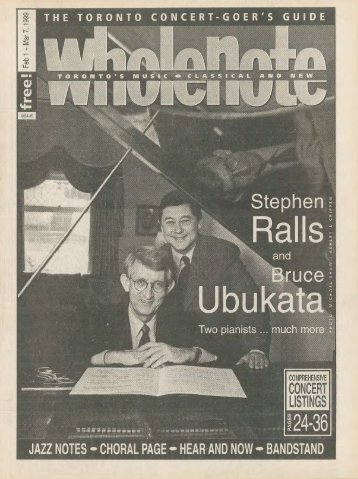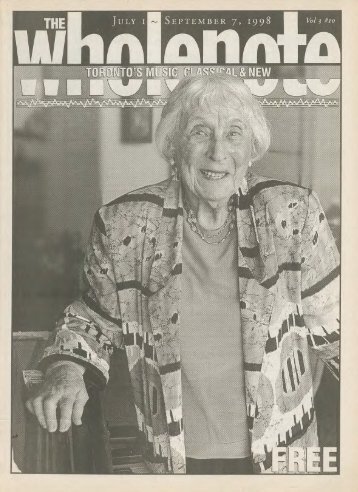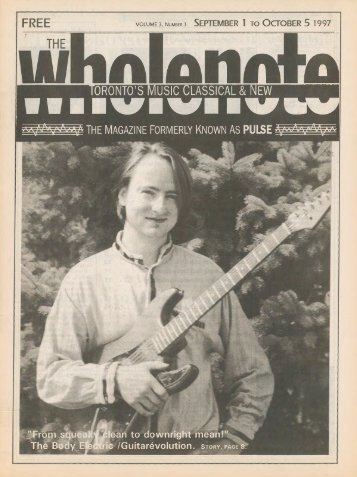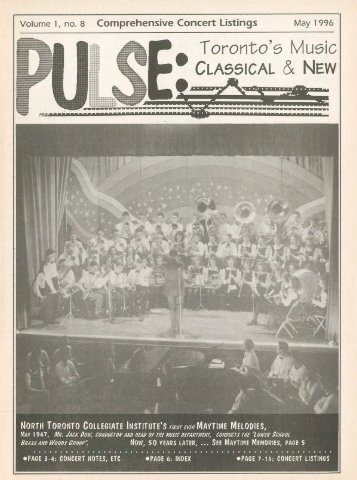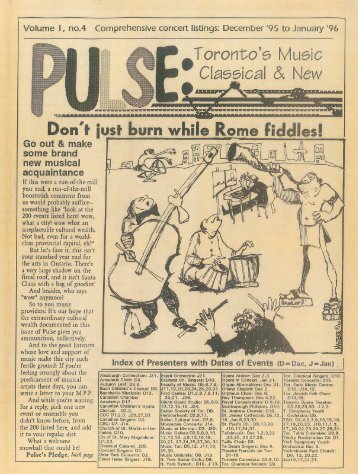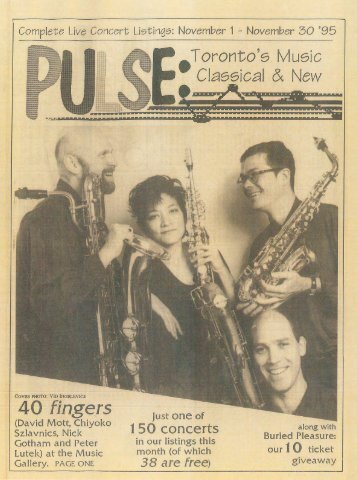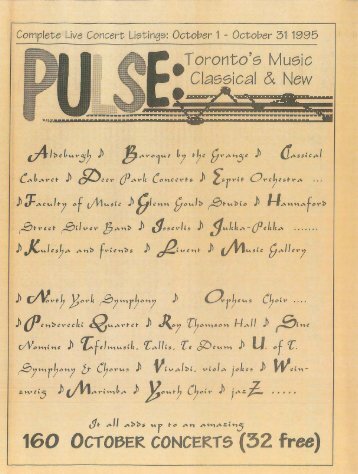Volume 21 Issue 7 - April 2016
- Text
- April
- Toronto
- Jazz
- Musical
- Symphony
- Arts
- Theatre
- Orchestra
- Concerto
- Choir
dovetailing lines of
dovetailing lines of Hood and Charuest on Star-Gazer. Thomson’s accompaniment to Hood’s voice on The Metal and the Flower flirts with silence to suggest birds and tiny woodland creatures, while the brashly vocal, plunger-muted solo of The Mole conveys generations of jazz trombone playing. Stuart Broomer The World Is Alright Aimée Butcher Independent (aimeebutcher.com) !! This debut album by singer/songwriter Aimée Butcher, recorded when she was only 22, demonstrates clearly her ability to compose, and deliver beautifully, melodies which are both substantially interesting and satisfyingly – almost frustratingly – catchy. The band, a quintet featuring Butcher’s voice, Chris Pruden on piano and keyboards, Brandon Wall on guitar, Jeff Deegan on bass and Robin Claxton on drums, all of whom are recent graduates of U of T’s hailed music program, has several feet planted firmly in the contrasting, sometimes feuding, worlds of jazz and pop. Songs like Stay or Drive and The World Is Alright are where Butcher’s hooks really shine: these are on the one hand pop songs, melodies that would feel at home in the mouths of singers like Alanis Morisette or Michael Bublé; and on the other hand recordings that highlight delicious, distinctly jazzy improvisations, including a simple, brief scat solo by Butcher. Especially notable is Pruden’s piano solo on the title track. It builds and develops perfectly, organized yet exciting; I always find myself saying “yeah” at the end. Butcher’s band also re-imagines songs by Joni Mitchell, Radiohead, and, delightfully, Jann Arden; the haunting duo of Butcher accompanied by Wall’s guitar on Arden’s It Looks Like Rain might be my favourite track. With a pulse only lightly suggested, on an ethereal bed of swelling chords, Butcher delivers Arden’s song as though it was her own. Bob Ben OUTgoing François Carrier; Steve Beresford; John Edwards; Michel Lambert FMR Records FMRCD400 (francoiscarrier. com) !! As much as this performance is entirely improvised the musicians also offer finely gauged and beautifully regulated music. The benefits are immediately apparent in OUTgoing, which is not only audaciously spelled, but contains music that is also unflinchingly dynamic. The players – saxophonist François Carrier, pianist Steve Beresford, bassist John Edwards and drummer Michel Lambert – offer music that is impetuous, inventive and laced with paprika. In one episode after another on this empirically existential recording the players make music that is technically challenging and impeccably pointed. There is a miraculous balance between simplicity, depth and virtuosity, all in the service of expression. Steve Beresford’s piano playing has an impish wit which, when pursued by the saxophone of Carrier, is pushed to address the saxophonist with an effect that borders on an almost “three-handed” playing, achieved by huge scales that sweep from top to bottom of the keyboard. Carrier’s own playing on saxophone as well as the exotic Chinese oboe, is informed by themes decorated with abandon, while Beresford passes the harmonics between himself and Carrier (especially on Kingsland Road) decorated with swirling arpeggios to once again give the illusion of there being three hands playing. The piece ends with passages of interlocking lines between saxophone and piano entwined with some impressive arco playing by bassist John Edwards. This is a sparkling disc which combines the talent of four astonishingly versatile musicians to create iridescent showers of notes cascading with echoing, scintillating exuberance. Raul da Gama Wrong Is Right Noisy Minority Intakt Records CD 262 NYC Five Angelika Niescier; Florian Weber Intakt Records CD 263 In Motion Richard Poole; Marilyn Crispell; Gary Peacock Intakt Records CD 264 !! At the very end of music’s spectrum, almost like planetary rumblings from outside the Milky Way, free improvisations imbue today’s music with a glorious sheen. Instrumental movements that one is accustomed to hearing are turned on their head enabling us to hear, with unabashed fascination, the explosive whimsy captured by some of the finest musicians alive today. Taking a leaf from Berg and Webern, Stravinsky and Stockhausen as much as from Anthony Braxton and Muhal Richard Abrams, Roscoe Mitchell and Lester Bowie, musicians – some who have been playing pretty conventional swing – have been blazing new trails, birthing, in every sense, a new avant-garde. This trend in Europe is vastly different from the one in America, which is rooted as much in the blues as it is in the music of Europe. Across the pond the “New Thing” dives daringly into triumphantly free improvisation that is almost completely bereft of the blues, although it might sometimes dig into jazz for idiomatic inspiration. Here are three wonderful discs from the Swiss label Intakt (intaktrec.ch) that exemplify everything that is bold and beautiful about European free improvisation. Wrong Is Right is a performance that provides a burst of acclamation with loud triumphant chords fittingly made by musicians who are the epitome of the triumph of musicianship. Saxophonist Omri Ziegele is also a voice artist and leads the power quartet that includes one of the finest trombonists in the business. Ray Anderson has been celebrated for his brilliant tone colours and impeccable use of timbre, all embodied in the highest form of artistry. The repertoire on this disc has music that is arranged in a suite-like manner. Everything – especially the brilliant Decimal System and Wrong Is Right – celebrates the unexplored nooks and crannies of the instruments’ vast repertoire. NYC Five is a beautifully constructed album of songs by one of the most extroverted saxophonists in Europe. Angelika Niescier might not be a name many are familiar with but the Cologne-based alto saxophonist inhabits many worlds seemingly at once. The music that is improvised is strikingly majestic and the written work – especially the ballad, Invaded – is likely to tear your heart out for its deep emotion and exquisite showers of notes by the pianist Florian Weber. The ubiquitous American drummer Tyshawn Sorey makes an electrifying appearance wherever he goes and this record is no exception. Watch out for the lightness and bounce of Ralph Alessi’s trumpet – the other American of repute on the album. “Cats with nine lives” is how tempting it is to describe pianist Marilyn Crispell, drummer Richard Poole and most definitely the monumental bassist, Gary Peacock, on In Motion. These leading exponents of their instruments almost intuitively bring dramatic, fresh tones and textures to notes and chords that you have heard hundreds of times before. The almost vocal styles of Crispell and Peacock have endeared them to generations of freethinking musicians and here they show why. Their explosive whimsy is captured on Backseat of the Galaxy, In Motion and Isle of Nowhere. The rest of the repertoire is no less 80 | April 1, 2016 - May 7, 2016 thewholenote.com
wondrous and is full of joyous evocation and revels in the über-virtuosity of all three musicians whose brilliance has no limits. Raul da Gama POT POURRI A Tribute Band of the Welsh Guards British Military Music Archive BMMAWG1502 (bmma.org.uk) !! This two-disc set commemorates the 100th anniversary of the establishment of The Band of the Welsh Guards. In 1915, as the British army expanded during the First World War, it was felt that Wales should be represented in the Brigade of Guards. The regiment was formed in February of that year. Soon after, when the establishment of a band was approved, the city of Cardiff helped to purchase a set of instruments, and the band began rehearsals in October. By the time of their first concert in the London Opera House on March 1, 1916, the band had already been in a studio and recorded the first six numbers of CD1. By the end of the year 1916, founding members of that band had recorded all 12 numbers on the first CD. While recording techniques have improved significantly, the audio quality is quite amazing. While CD1 contains mostly patriotic music, CD2, recorded between 1921 and 1940, contains a variety of musical styles including several novelty numbers of the type performed by bands in the years between the wars. Such numbers as Gaiety Echoes and Wedded Whimsies certainly aren’t likely to be found in the repertoire of concert bands of 2016. One particular novelty number that used to be very popular is The Whistler and His Dog. Written by Arthur Pryor, famed trombone virtuoso of the Sousa band, it has many of the band members whistling the melody and then ends with loud barking. This CD even contains a couple of numbers by the Dance Orchestra. All in all, an excellent preservation of the musical history of the Welsh Guards. Jack MacQuarrie Orono Cornet Band Orono Cornet Band Great Canadian Town Band Festival (oronocornetband.com) !! Some years ago, trombone player and old town band music fan, David Climenhage established the Great Canadian Town Band Festival in the small town of Orono, east of Toronto. While the festival no longer operates, Climenhage has now focused on another aspect of his interest in the music of the early town bands in Canada. When he got together with Toronto musician Herbert Poole they discovered that they had a common interest in the collection and restoration of old brass musical instruments. They soon decided that, since their instruments were made to produce music, not just to be admired, they should form a band. The result is Orono Cornet Band which performs the music of the period when the instruments were built. The result is this recording with music composed between 1855 and 1890. Top flight musicians performing on period instruments, ranging from cornets to such lesser-known oddities as the ophicleide and helicon, provide a rare insight into the musical life of small town Canada before motion pictures, radio or television. Where else could you hear such works for a town dance as the Take Me Home Quickstep or the Blue Dahlia Polka Mazurka. Unfortunately, there are no program notes, and while I had never heard of any of the composers, a little research provided much information on one of them. F. H. Torrington founded the Toronto College of Music which became the first music affiliate of the University of Toronto. In 1894 he conducted the very first concert in Massey Hall. For devotees of early brass band music this recording is a must. Jack MacQuarrie Something in the Air Preserving Rediscovered Free Music Classics KEN WAXMAN Fully grasping the intricacies of musical history often depends on the availability of recorded documents. That’s why many musical histories are re-evaluated once hitherto little known performances become accessible. This is especially crucial when it comes to completely or mostly improvised sounds. Reissued and/or rediscovered sessions, which preserve ephemeral moments, confirm the music’s wide dissemination. More importantly they add the equivalent of additional sentences that provide a fuller understanding of the free music story. Consisting of almost 78 minutes of music, First Duo Concert (Emanem 5038 emanemdisc.com) is particularly relevant because it captures one dozen interactions between American multi-reedist Anthony Braxton and British guitarist Derek Bailey. Recorded in 1974, it displays the similarities, and as significantly, the differences between free music concepts. Even at this early date Bailey and many of his London-based colleagues rejected the idea of playing anything but in-the-moment music. But as true to the Association for the Advancement of Creative Musicians (AACM) ethos as Knights Templar would be to their creed during the Crusades, the saxophonist/clarinetist brought not only familiarity with the blues form, but also an interest in semi-composed material and extended explorations in certain techniques to the date – concerns that remain with him more than 40 years later. When the completely improvised Area 3 (open) is reached, congruence turns to cooperation. What originally could have been the jolts produced when two blindfolded players collided with one another turns into a motley garment whose patchwork can envelop grinding string buzzes and harsh clangs as well as resonating timber wolf-like saxophone snarls and moderated bass clarinet ostinato. If gating banjo-like reverb plus internal body tube puffs and renal-like vibrations from his reed collection on Braxton’s part still disturb the evolving continuum like pointed flecks in rough wood grain, then his unexpected peeps and pops lessen as both aim towards measured expression. Allowing each partner’s full expression during single unaccompanied tracks, the duo reaches the zenith of mutual understanding on the extended Area 11 (open). While each still tests the limits of the other’s convictions with the zeal of a small child taunting the family pet, harsh, oblique strums and quivering, aviary-styled peeps from the clarinet finally dovetail enough so that aggressive string thumb taps fit into an accompanying groove, as later thewholenote.com April 1, 2016 - May 7, 2016 | 81
- Page 1 and 2:
PRICELESS! Vol 21 No 7 APRIL 1 - MA
- Page 3 and 4:
MUST-SEE SPRING THOMAS SØNDERGÅRD
- Page 5 and 6:
Volume 21 No 7 | April 2016 FEATURE
- Page 7 and 8:
If any of the performers were to as
- Page 9 and 10:
Music TORONTO musicians - Reich and
- Page 11 and 12:
an Ontario government agency Halyna
- Page 13 and 14:
CARMEN Bizet TICKETS FROM $ 50 CARM
- Page 15 and 16:
choral works ever, written entirely
- Page 17 and 18:
AMERICAN BACH SOLOISTS/GASLAMP PROD
- Page 19 and 20:
“The last couple of years, I play
- Page 21 and 22:
an Ontario government agency un org
- Page 23 and 24:
great chamber music downtown STRING
- Page 25 and 26:
TM the composer’s intentions; to
- Page 27 and 28:
Chopin and Schubert that the movies
- Page 29 and 30: Black CMYK Pantone an Ontario gover
- Page 31 and 32: It’s as if every choir in the reg
- Page 33 and 34: an imaginative move, Mazzoleni Song
- Page 35 and 36: concerts and many more events at se
- Page 37 and 38: Scotia International Tattoo. We wer
- Page 39 and 40: and Tobin Stokes. Members of the Bi
- Page 41 and 42: Thursday April 7 ●●12:00 noon:
- Page 43 and 44: “Enigma”. Heidi Van Hoesen Gort
- Page 45 and 46: Simon Shaheen’s Zafir: Musical Wi
- Page 47 and 48: Disconnected (Family Concert). Chic
- Page 49 and 50: Thursday April 28 ●●12:00 noon:
- Page 51 and 52: Scott St. John, violin Sharon Wei,
- Page 53 and 54: Faces of Saturday, May 7, 2016 Mark
- Page 55 and 56: Bldg., 50 Stone Rd. E., Guelph. 519
- Page 57 and 58: ●●7:30: Menno Singers/Pax Chris
- Page 59 and 60: doors, mostly from contraband recor
- Page 61 and 62: April 23 4th Annual Anniversary ‘
- Page 63 and 64: Lydia Pederson COMMUNITY ACADEMY JU
- Page 65 and 66: TIME FOR SPRING CLEANING! Is that a
- Page 67 and 68: Making music with others? I joined
- Page 69 and 70: DISCOVERIES | RECORDINGS REVIEWED D
- Page 71 and 72: Narratives on Life - music for cell
- Page 73 and 74: Keyed In ALEX BARAN Janina Fialkows
- Page 75 and 76: VOCAL The Way of the Pilgrim Toront
- Page 77 and 78: to compose these extra pieces popul
- Page 79: that doesn’t pin the listener dow
- Page 83 and 84: Old Wine, New Bottles | Fine Old Re
- Page 85 and 86: KOERNER HALL IS: “ A beautiful sp
- Page 87 and 88: Tanya Tagaq Kronos Quartet Dawn of
Inappropriate
Loading...
Mail this publication
Loading...
Embed
Loading...
























